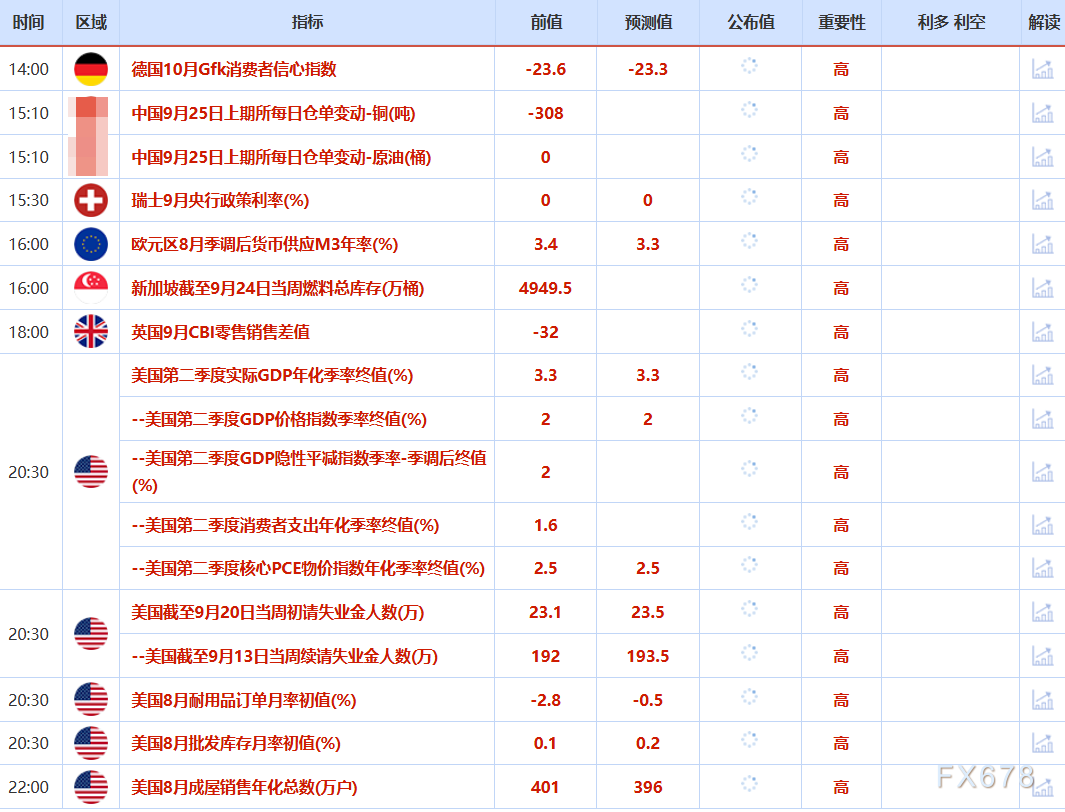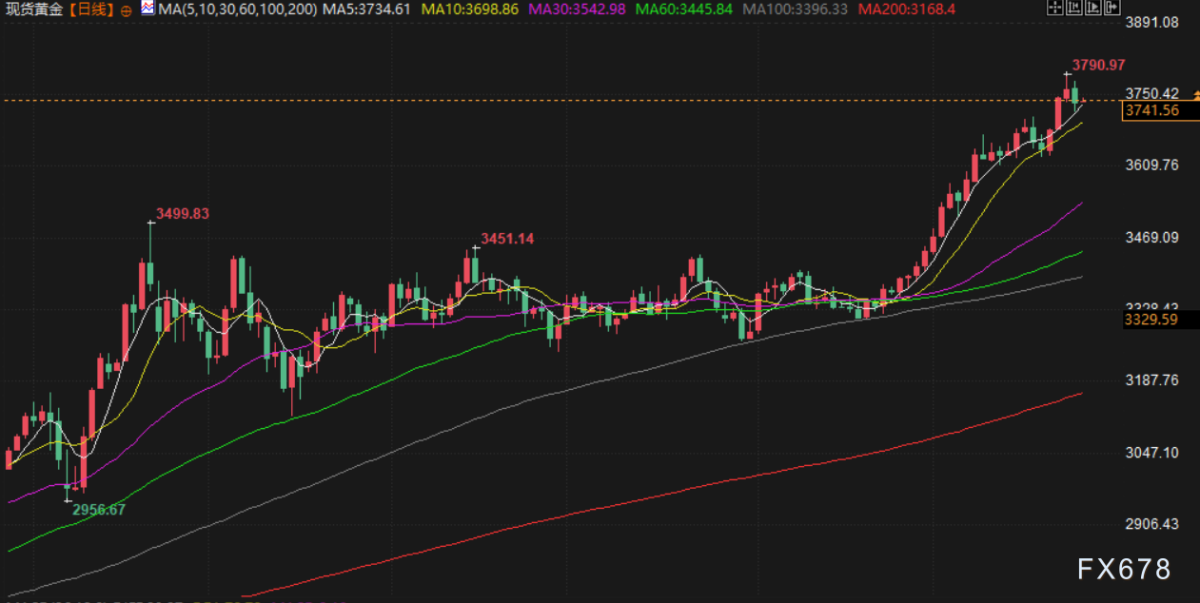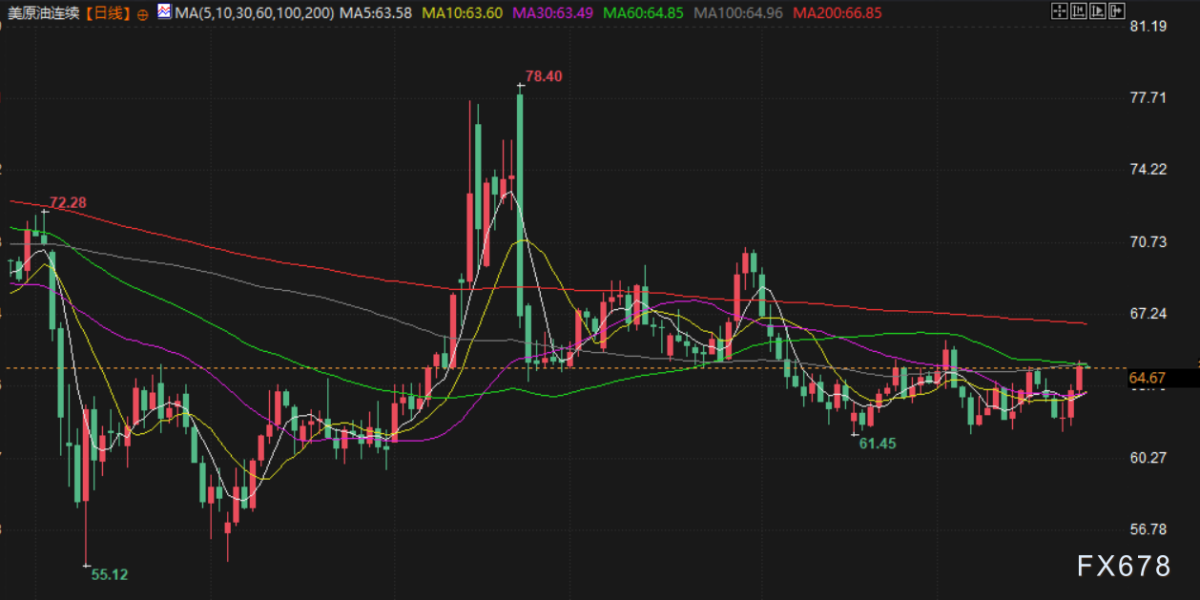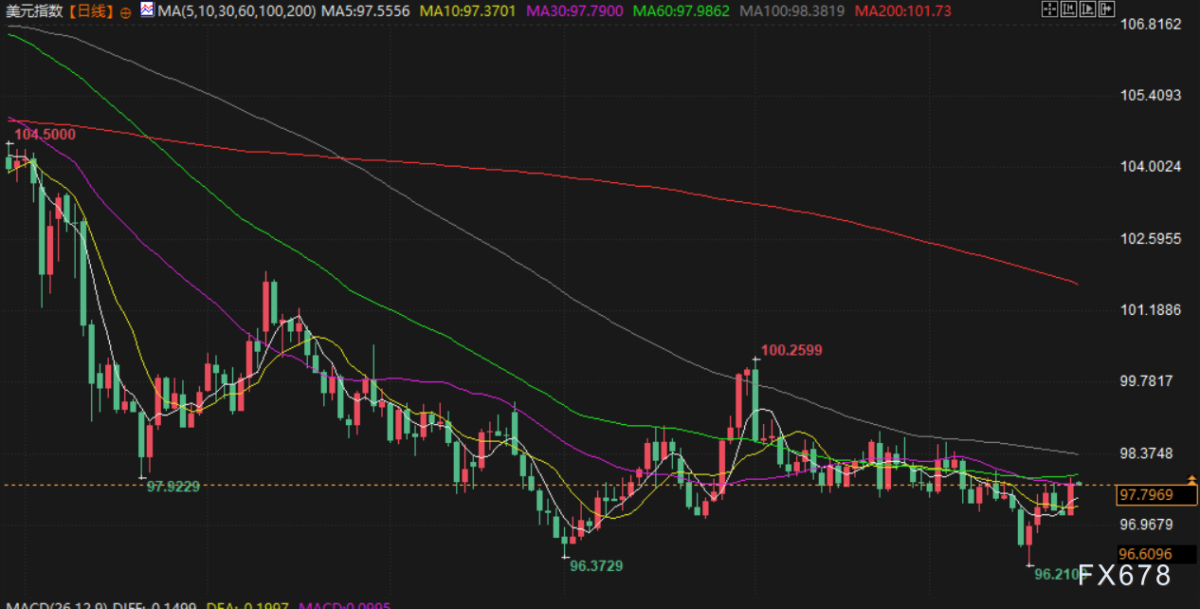In the Asian trading session early Thursday (Beijing time, September 25), spot gold was trading near $3,740.71 per ounce, retreating from Wednesday’s session due to a stronger US dollar as investors awaited upcoming economic data later in the week for further clues about the Federal Reserve’s policy trajectory. West Texas Intermediate (WTI) crude oil was trading at approximately $64.71 per barrel, with prices rising nearly 2% on Wednesday to hit a seven-week high. Last week’s unexpected decline in US crude inventories, coupled with disruptions to exports from Iraq, Venezuela, and Russia, heightened concerns over tightening supplies.

Key Focus of the Day

Williams, the permanent voting member of the FOMC and President of the New York Fed, delivered welcoming remarks at the Fourth Annual Conference on the International Role of the Dollar, while Fed officials Schmid and Goolsbee also gave speeches.
Stock Market
US stocks fell for a second consecutive session on Wednesday as major indices approached record highs, prompting investors to take profits following Federal Reserve Chair Jerome Powell’s caution that stock prices might be elevated. The market is also awaiting inflation data due later this week.
 Investors are attempting to assess the future path of interest rate cuts by the Federal Reserve, which is currently trying to support the US economy without triggering another round of inflation amid signs of weakness in the labor market.
Investors are attempting to assess the future path of interest rate cuts by the Federal Reserve, which is currently trying to support the US economy without triggering another round of inflation amid signs of weakness in the labor market.
Earlier this week, all three major indexes, along with the small-cap Russell 2000 index, simultaneously reached new record closing highs for the first time in several years. On Tuesday, Powell noted that asset prices “appear somewhat elevated.” He emphasized the need for the Fed to carefully weigh its future rate decisions, highlighting differing views among his colleagues regarding the policy outlook. Some analysts have drawn parallels between Powell’s remarks and former Fed Chair Alan Greenspan’s famous warning of “irrational exuberance” driving up asset prices back in 1996.
The Federal Reserve’s 25-basis-point rate cut last week provided a boost to the typically lackluster September stock market performance. Investors are now betting on further monetary policy easing in the future.
Ron Albahary, Chief Investment Officer of LNW based in Philadelphia, stated that the current price-to-earnings ratio of the S&P 500 at 23 to 24 times reflects market expectations of an average annual earnings growth of about 15% over the next five years. This does sound relatively high, but we are not timing the market. However, it seems reasonable for investors to reduce their positions slightly following Powell’s comments.
The Dow Jones Industrial Average fell 0.37% to 46,121.28 points, the S&P 500 declined 0.28% to 6,637.98 points, and the Nasdaq Composite dropped 0.33% to 22,497.86 points.
Some stock valuation metrics have risen to their highest levels since 2021, and if they continue climbing, they will reach levels seen during the dot-com bubble. The materials sector of the S&P 500 fell by 1.6%, making it the worst-performing sector.
On the other hand, the energy sector of the S&P 500 rose 1.2%, becoming the best-performing sector, driven by rising oil prices. An unexpected decline in U.S. crude oil inventories pushed oil prices to a seven-week high.
Data released on Wednesday showed that sales of newly built single-family homes in the U.S. surged unexpectedly by 20.5% in August.
In terms of individual stocks, shares of Lithium Americas nearly doubled, closing at $6.01, after reports that the Trump administration was seeking to acquire up to a 10% stake in the company.
Micron Technology fell 2.8% after reporting quarterly results, while Oracle dropped 1.7% following reports that the company planned to issue $15 billion in corporate bonds.
Investors will shift their focus to the upcoming Personal Consumption Expenditures (PCE) price index data later this week, which is the Federal Reserve’s preferred inflation gauge.
Gold Market
Gold prices retreated on Wednesday due to a stronger dollar, pulling back from record highs reached in the previous session, while investors awaited economic data to be released later in the week for further clues on the Federal Reserve’s policy path.

Spot gold fell 0.8% to $3,734.58 per ounce, while U.S. gold futures for December delivery closed down 1.2% at $3,768.10. The yield on the benchmark 10-year U.S. Treasury bond edged higher.
Phillip Streible, Chief Market Strategist at Futures, stated that gold is still digesting some comments from the Federal Reserve and geopolitical tensions with Russia. The market remains somewhat cautious ahead of the release of certain economic data.
Federal Reserve Chair Jerome Powell provided no new clues on Tuesday regarding the future path of interest rates, emphasizing the need for the central bank to cautiously balance the risks of stubborn inflation against a slowing labor market.
According to the CME FedWatch tool, the market expects another 25-basis-point rate cut this year, with a 94% probability of a rate cut in October and a 77% probability in December.
The current focus is on Thursday’s weekly U.S. initial jobless claims data and Friday’s release of the U.S. Personal Consumption Expenditures (PCE) price index, which is the Federal Reserve’s preferred inflation gauge.
On the geopolitical front, Ukraine’s military said on Wednesday that it had attacked two oil pumping stations in Russia’s Volgograd region overnight. During periods of geopolitical and economic uncertainty, safe-haven gold becomes more attractive.
Spot silver fell 0.4% to $43.84 per ounce. Platinum dropped 0.7% to $1,468.44, while palladium declined 0.7% to $1,211.45.
Oil Market
Oil prices climbed nearly 2% on Wednesday, hitting a seven-week high, as U.S. crude inventories unexpectedly declined last week. Additionally, export disruptions in Iraq, Venezuela, and Russia heightened concerns over tightening supplies.

Brent crude futures rose 2.5% to settle at $69.31 per barrel, while U.S. crude futures climbed 2.5% to close at $64.99. Brent crude reached its highest closing level since August 1, and U.S. crude hit its highest closing level since September 2. The U.S. Energy Information Administration (EIA) reported an unexpected decline of 607,000 barrels in U.S. crude oil inventories last week.
Surveys showed that analysts had forecast a 235,000-barrel increase in U.S. crude inventories. Market sources on Tuesday cited data from the American Petroleum Institute (API), indicating a 3.8 million-barrel drop in crude inventories last week.
John Kilduff, a partner at Again Capital, noted, “Given the report showing declines across all inventories, this EIA report has provided some support,” referring to reductions in crude oil, distillate, and gasoline stocks.
The overnight attack by Ukrainian forces on two oil pumping stations in Russia’s Volgograd region also supported oil prices. The city of Novorossiysk declared a state of emergency; it is Russia’s main Black Sea port with key terminals for oil and grain exports.
The Dallas Fed reported on Wednesday that oil and gas production and activity in Texas, Louisiana, and New Mexico—the major U.S. oil-producing states—slightly declined in the third quarter of 2025.
Iranian Oil Minister Mohsen Paknejad stated that there would be no “new burdensome restrictions” on Iran’s oil sales. Currently, Tehran and European powers are working to reach an agreement to prevent the UN from reinstating sanctions against Iran this week.
Chevron’s limitation on Venezuelan oil exports due to U.S. licensing issues has intensified short-term bullish sentiment in the market.
Forex
The U.S. dollar rose against the Japanese yen, Swiss franc, and euro on Wednesday after Federal Reserve Chair Jerome Powell expressed caution regarding further monetary easing. The dollar gained 0.54% against the Swiss franc to 0.795, ending a two-day losing streak. The euro fell versus the dollar after Germany’s September business confidence index unexpectedly dropped. After rising in the previous two sessions, the euro ended down 0.69% at $1.1734 in New York trading. The pound fell 0.58% to $1.3443 but remained stable against the euro at £0.8727.

Marvin Loh, Senior Global Market Strategist at State Street based in Boston, stated, “The US dollar is slightly firmer against most G10 currencies but remains within a range of volatility and consolidation. According to our flow and positioning data, the dollar is still significantly underweight among long-term institutional investors, so I believe it is in a consolidation phase, which is exactly what is currently happening.”
Powell maintained a cautious tone on Tuesday, stating that the Federal Reserve still needs to balance the risks between high inflation and a weak labor market in future interest rate decisions. The market expects the Fed to cut rates by 25 basis points at each of its two remaining meetings this year and once more in the first quarter of 2026, consistent with the Fed’s guidance following last week’s meeting.
This week’s US economic data will be in focus, particularly the Personal Consumption Expenditures (PCE) price index due on Friday, a key indicator shaping market expectations for the Fed’s next policy move.
Loh added, “We are still assessing the Fed’s moves on a data-dependent basis, and this will act as a catalyst for interest rates and the US dollar, determining whether the market perceives the Fed as becoming more aggressive or hawkish.”
The US Dollar Index, which measures the dollar against six major currencies, rose by 0.65% to 97.87, attempting to recover losses after two consecutive days of declines.
Candidates vying for the leadership of the ruling Liberal Democratic Party answered reporters’ questions on Wednesday. Sanae Takaichi, one of the frontrunners known for her dovish stance on fiscal and monetary policy, stated that monetary policy is determined by the Bank of Japan, but higher interest rates could affect mortgage rates and corporate investment.
The US dollar rose 0.83% against the yen to 148.85 yen, reaching its highest level in three weeks and ending a three-day losing streak.
New Zealand Finance Minister Nicola Willis announced on Wednesday the appointment of Anna Breman as the new Governor of the Reserve Bank of New Zealand, making her the first female chair of the institution. Breman, currently the First Deputy Governor of the Swedish Central Bank, will take office on December 1. Following the announcement, the New Zealand dollar fell 0.79% to $0.581.
The Australian dollar fell 0.29% against the US dollar to $0.658. Previously released data showed that consumer price inflation (CPI) in August rose 3% year-on-year, up from 2.8% in July and slightly above the median forecast of 2.9%. This comes less than a week before the Reserve Bank of Australia’s next policy meeting.
International News Highlights
Official U.S. Announcement: 15% Tariff Imposed on EU Cars
On September 24 local time, the Trump administration in the United States issued an official announcement to implement the trade agreement reached between the United States and the European Union, confirming that a 15% tariff would be imposed on EU-imported cars and automotive products starting from August 1. Additionally, the document listed tariff exemptions for certain pharmaceutical compounds, aircraft components, and other imported goods. On July 27 local time, U.S. President Donald Trump stated that the United States had reached a new trade agreement with the European Union, imposing a 15% tariff on EU goods entering the U.S. European Commission President Ursula von der Leyen noted that the 15% rate was the best outcome the European Commission could achieve.
US Energy Secretary: America is Ready to Replace All Russian Oil and Gas Imports to Europe
US Energy Secretary Wright stated that the United States is “ready to replace all Russian natural gas and oil products entering Europe.” He further added that the US has the “capacity” to meet Europe’s energy needs. According to him, this move aims to advance Trump’s “peace agenda.”
The U.S. Democratic Party unveils energy plan to drive momentum for the 2026 midterm elections.
According to a draft bill released by the U.S. House Democrats on September 24, tax incentives for renewable energy projects will be reinstated, and the Low-Income Energy Assistance Program will be expanded. The blueprint aims to curb rising energy costs for Americans by increasing investment in wind and solar power, building transmission lines to strengthen the grid, and reducing the Trump administration’s support for fossil fuel projects instead of renewable energy. The discussion draft includes provisions such as restoring renewable energy tax credits, establishing investment tax incentives for new transmission lines, expanding the Low-Income Home Energy Assistance Program, and providing year-round reliable heating and cooling services for low-income households.
Dallas Fed Survey: U.S. Shale Industry Cites Policy Missteps as Cause of Lost Dynamism
The U.S. oil and gas industry is escalating its private dissatisfaction with President Trump’s energy agenda, warning that policy missteps are harming the world’s largest oil producer. This criticism was revealed in the latest energy survey by the Federal Reserve Bank of Dallas released on Wednesday. The quarterly report, widely read within the energy sector, compiles anonymous and unfiltered comments from respondents at production and service companies. One respondent was quoted as saying, “The U.S. shale business is broken. Once the most dynamic energy engine in the world, it has now been hollowed out by political hostility and economic ignorance.” Some experts predict that as OPEC+ members continue to increase production and Trump encourages the U.S. to significantly boost output to achieve his goal of ‘energy dominance,’ the global oil market is heading toward a supply glut. The result has been a steady decline in oil prices. The U.S. crude benchmark, West Texas Intermediate (WTI), has fallen nearly 10% in 2025. Based on the average forecast from executives at 136 oil and gas companies in the southwestern United States, WTI is expected to close at $63 per barrel by the end of 2025, marking a 7.4% downward revision from predictions made just over two months ago.
The new Thai cabinet was sworn in.
Thailand’s new cabinet, led by Prime Minister and Interior Minister Anutin Charnvirakul, paid homage to King Maha Vajiralongkorn at Dusit Palace in Bangkok on the evening of the 24th and took the oath of office in the royal presence. Following the conclusion of the swearing-in ceremony that evening, Anutin presided over a special cabinet meeting to discuss the draft policy statement that will be presented to the parliament. Anutin is expected to deliver the policy address to the parliament next week. (Xinhua News Agency)
Hungarian Foreign Minister: Western European Countries Adopt Double Standards on Energy Issues
On the 24th local time, Hungarian Foreign Minister Szijjártó, in an interview in New York, stated that some European politicians accusing Hungary of purchasing Russian energy are attempting to conceal the fact that most Western European countries are still buying Russian oil through indirect means. The latest data shows that only 2.2% of Russia’s crude oil export revenue flows to Hungary, exposing those Western European nations that purchase Russian oil via Asian countries as intermediaries. Szijjártó noted that energy supplies through the Adriatic oil pipeline are insufficient to meet Hungary’s needs. “Tests conducted in recent weeks have clearly demonstrated that, under current technical conditions, this pipeline is unable to consistently transport large quantities of oil.” Hungary’s geographic location dictates the reality that it cannot break away from dependence on Russian energy—a fact that cannot be changed. (CCTV)
Deutsche Bank: The U.S. government may face its first shutdown since the winter of 2018-19.
Traders are cautiously awaiting Thursday’s initial jobless claims data and Friday’s PCE inflation data, while closely monitoring tricky developments that could trigger a U.S. government shutdown. U.S. President Trump canceled crucial talks with Senate Minority Leader Schumer and House Minority Leader Jeffries, which were expected to prevent a government shutdown ahead of the September 30 deadline. Deutsche Bank analyst Jim Reid noted in a Wednesday morning report to clients: “The cancellation of the talks has sparked renewed concerns that funding may run out by next week’s deadline, potentially leading to the first government shutdown since the winter of 2018-19.”
BoE Governor Bailey Says There Is Room for Further Rate Cuts as Consumers Remain Cautious
Bank of England Governor Andrew Bailey has raised the prospect of further interest rate cuts and warned that cautious Britons are cutting back on dining out and shopping. He stated, ‘There is still room for rates to come down, but the timing and extent will depend on the trajectory of inflation,’ and added, ‘The labor market in particular is already showing signs of softening, with some evidence in employment data.’
Ukrainian delegation to visit the U.S. at the end of September to discuss military cooperation; U.S. focuses on drones.
On September 24 local time, Ukrainian Ambassador to the United States Oksana Markarova stated that a Ukrainian delegation would visit the U.S. at the end of September to negotiate the legal aspects of a joint weapons production agreement. When asked whether Ukrainian President Volodymyr Zelenskyy and U.S. President Donald Trump discussed bilateral military cooperation during their meeting, Markarova gave an affirmative response and emphasized that the discussions were quite in-depth. It is reported that the military cooperation involves joint weapons production and may also include sales to other countries. Markarova further revealed that this military cooperation agenda was proposed by Zelenskyy, and Trump responded very positively. He spent several minutes praising Ukraine’s innovation capabilities and strength, sending a positive signal. Trump also expressed hope that the Ukrainian team could arrive in the U.S. on September 30 to negotiate the legal aspects of the agreement. Markarova said that the U.S. side is mainly interested in various types of drones. Zelenskyy stated that discussions on different types of drones could be held based on the needs of the U.S. government.
国内要闻
Cumulative production of China’s first national-level shale oil demonstration zone surpasses 5 million tons.
Today (September 25), the cumulative production of China’s first national-level continental shale oil demonstration zone — PetroChina’s Jimsar Shale Oil in Xinjiang — has exceeded 5 million tons, marking a shift in China’s shale oil development from technological exploration to a phase of stable output. The Jimsar Shale Oil Demonstration Zone is located in the eastern part of the Junggar Basin, covering an area of 1,278 square kilometers, with oil reservoirs buried over 3,800 meters deep. Since the beginning of this year, capacity construction in the demonstration zone has continued to accelerate, with 48 wells drilled and daily production surpassing 5,000 tons for the first time, setting a new historical record. (CCTV News)
The European Automobile Manufacturers Association (ACEA) released its 2025 mid-year report, highlighting robust growth in the Chinese market.
The ‘2025 Mid-Year Global and EU Automotive Industry Economic and Market Report’ recently published by the European Automobile Manufacturers Association (ACEA) shows a clear divergence in the global automotive market. The Chinese market has seen robust growth, while overall demand and production in Europe have faced pressure. The report notes that the economic outlook for the EU remains cautiously optimistic. The EU’s GDP is projected to grow by 1.1% in 2025, with inflation expected to fall to 2.3%, and an average of 1.9% in 2026, below the European Central Bank’s target of 2%. Employment is expected to continue rising, with the unemployment rate forecast to drop to a historic low of 5.7% by 2026. Global vehicle registrations increased by 5% in the first half of the year, reaching 37.4 million units. The Chinese market grew by 12%, driven by policy support; the North American market increased by 2.5%; while Europe as a whole declined by 2.4%, including a 1.9% drop in the EU market. However, Turkey, EFTA countries, and the UK played stabilizing roles. (Xinhua Finance)
